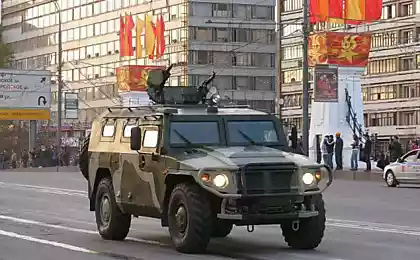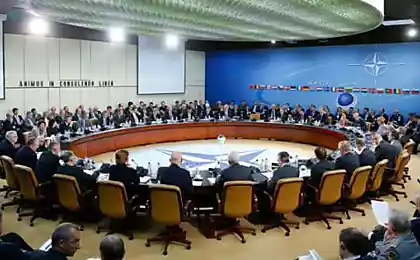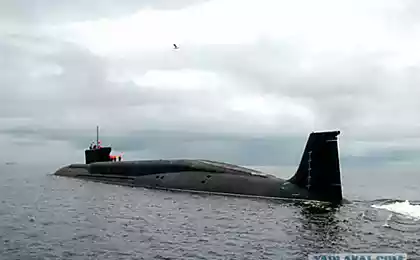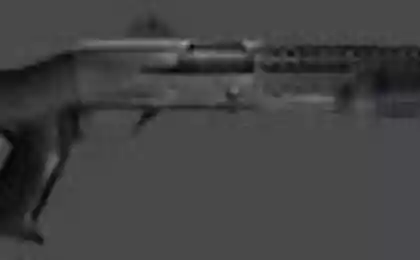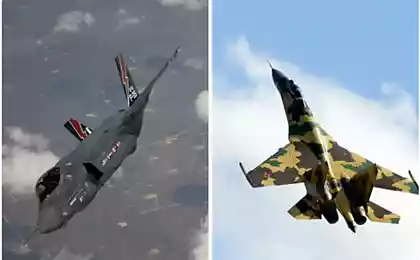1005
Tunguska (sa-19 Grison by NATO classification)
Continued. Start cm. forum3/topic250866.html
Designed to protect the tank and motorized rifle objectives of low-flying aircraft and helicopters, some types of cruise missiles and to destroy ground lightly armored targets and manpower.
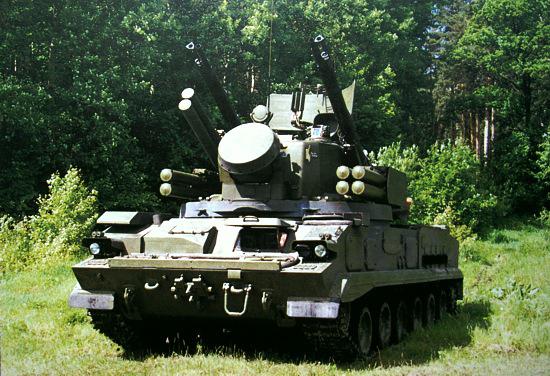
Features of the complex: - combined missile-gun armament; - Combined radar and optical control system of missile and gun armament undertaking vzaimokoordinirovannoe target tracking missiles, and night and day under the conditions of optical visibility. The system provides: - high accuracy of aerial target, regardless of the height of its flight, shelling land targets; - Passive mode of air targets and high noise immunity; - High reliability and stability of the complex when using the optical channel with a radar channel vzaimokoordi- nated by their operation, that is, the possibility of transition to the process of shooting from one channel to another or joint use; - Universality of combat use, ie effective engagement of air targets, not only as a key, but the ground lightly armored vehicles and enemy; - Effective engagement of targets cannon armament in motion, with short stops; - Automatic guided missiles (with correction of small deviations operator guidance); - Short reaction time (6 - 10); - Off-line combat operation; - Automatic exchange of information with the battery command post (improving the efficiency of combat battery); Complex (battery) "Tunguska-M1» includes: anti-aircraft guns 2S6M1 (6 tanks in the battery), surface-to-air missile 9M311-1M (8 missiles on launchers), 30-mm rounds, transportation and loading vehicle 2F77M (up to 3 in the battery ).
The picture dvuzhstvolny anti-aircraft gun.

Missiles complex "Tunguska-M1" - two-stage bikalibernaya surface-to-air missile with a detachable solid booster - 9M311-1M. The missile has a high maneuverability, allowing the striking speed and maneuvering targets. Navede- of missiles at the target - radio. Rocket 9M311-1M delivered to the troops in transport-launch container in the fully equipped condition and requires no maintenance for 10 years.
Gun armament is represented by two double-barreled anti-aircraft guns 2A38M. The high rate of fire (total rate - 5000 rds. / Min.) Can effectively hit the target speed in the zone of fire, even a short time. In combination with high precision targeting by stabilizing the line shots and automatic tracking cannons highly effective in shooting at air targets, including the move. Means of maintenance (MOT) includes: - repair and maintenance of machines 1R10-1M1, 2F55-1M1; - TO 2V110-1 machine; - Workshop MTO SPA; - Automated control and test station 9V921M. They provide: - routine maintenance; - Maintenance and repair during operation and storage. Training facilities and 1RL912 9F810 designed for teaching and training the commander, operator and gunner fighting techniques work in different environments target environment.
Initially the "Tunguska" was seen as a purely gun system, created to replace "Shilka" and differs from it by increasing the caliber automatic antiaircraft guns. The experimental studies have shown that the transition from a shell of caliber 23 mm to 30 mm caliber projectile associated with the two-threefold increase in the mass of the explosive, allows 2-3 times to reduce the number of hits required to destroy aircraft.
In order to expand the zone of fire purposes until the turn of the use of airborne weapons and increase the combat power of the "Tunguska" at the initiative of the PCU MOS and 3 Research Institute of Ministry of Defense it was considered appropriate to put on the ZSU further Missiles with a system of optical sight and radio remote SAM providing engage targets at altitudes of up to 3500 m and at distances up to 8 km. In a duel situation bout combat helicopter with anti-aircraft complex track of time it is not even a second, and their share - it all depends on whose rocket will reach before the enemy, hitting him thwart enemy missile guidance. The smallest missile flight time is provided with rapid acceleration followed by a high-speed flight, but by inertia, speeding, conventional rockets quickly decelerated by air resistance. Tula designers found an original solution. Two-stage rocket made, but the engine was equipped only the first step, made in a rather large caliber - 152 mm. Upon completion of 2, 6 seconds after the start, it was separated without impeding further flight accelerated to velocities of 900 m / s maximum uzhatye twice thinner, good streamlined sustainer stage application of such a scheme allowed halve weight compared with single-stage rocket with the same characteristics, laid in the amount of about 40 kg Most of the cruise stage was elongated rod warhead undermines team from the laser blaster, and a direct hit (the likelihood of which reached about 60%) - contact fuze. The lack of engine sustainer stage preclude smoke boresight target, and on the job site starting rocket engines specially Gone away up practicing "hill." The position determined automatically by a rocket tracer, similar to the way it was done in a semi-automatic anti-tank systems. The use of optical systems to provide an angular pointing accuracy, repeatedly exceeding the performance radar, and the lack of all-weather was not a significant disadvantage, as helicopter gunships in those years, too, could act only in the line of sight of their goals.
Here's how this rocket vygljadet:

Combat gear consists of a rocket warhead, a proximity sensor target and contact fuze. Occupies almost the entire length of the cruise stage warhead weighing 9 kg it is in the form of a large bay with extension rod striking elements, to improve the efficiency surrounded fragmentation jacket. Warhead provide a cutting action on the elements of the airframe goals and incendiary - the elements of its fuel systems in small slips (up to 1, 5 m) also provides a high-explosive action. Undermining the warhead was carried out at a distance of 5 meters from the goal of a non-contact sensor signal, and a direct hit (the likelihood of which reached about 60%) - contact fuze.
The proximity sensor weight 0, 8 kg consisted of four semiconductor lasers forming eight pointed directional pattern perpendicular to the longitudinal axis of the rocket. The reflected laser signal from the target accepted photodetectors. Range confident response was 5 m, a reliable failure - 15 m. The proximity sensor is cocked by radio for 1 km to the meeting with the aim of missiles and missile firing at ground targets from turning off before the start. Restrictions on the height control system of missiles had.
Onboard equipment SAM includes an antenna-waveguide system, electronic control unit, the coordinator gyro unit steering gear, tracer, power supply.
The rocket applied passive damping aerodynamic airframe missiles in flight, which corrects the control loop in the transmission of commands to the computer system of the missile combat vehicle. It is possible to obtain a sufficiently accurate targeting, reduced weight and size of the onboard equipment and missiles in general. The station detection purposes
The station detection purposes combat vehicle complex "Tunguska" is coherently pulsed radar Omnidirection UHF waves. High frequency stability of the transmitter, configured as a master oscillator and amplifier chain, the use of a filter circuit moving target provides a high rejection ratio clutter (30..40 dB) that allows detection of targets against the background of intense reflections from the underlying surface, and clutter. By selecting the carrier frequency and the pulse repetition frequency was achieved unambiguous definition of the range and radial velocity, which allowed to implement target tracking in range and azimuth, automatic target designation station tracking and delivery of the current range in the digital computing system in the formulation opponent intensive interference in the range tracking station . For operation in motion stabilized antenna is an electromechanical method using signals from the sensors and measurement systems kachek creep rate.
When the pulse power 7-10 kW transmitter, receiver sensitivity about 2h10E-14 W, the width of the antenna pattern in azimuth of 5 ° and 15 ° elevation station with probability 0 9 detects fighter flying at altitudes of 25-3500 m, on range 16-19 km. Resolution station was 500 m in range, 5-6 ° in azimuth and 15 ° in elevation. Mean square error in determining the coordinates of the target are within 20 m range, 1 ° in azimuth and 5 ° elevation. Station tracking
Tracking station is a coherent pulse-centimeter-band radar system with dual-channel support on the angular coordinates and the filter circuits moving target channels avtodalnomera corner and automatic tracking. Coefficient of clutter suppression and clutter was 20-25 dB. The station moves to the auto tracking modes targeting the sector and the search target. Sector Search is 120 ° in azimuth and 0-15 ° in elevation.
When the pulse transmitter power of 150 kW, the receiver sensitivity 3h10E-13 W, the width of the antenna pattern 2 degrees. (azimuth and elevation) station with a probability of 0, 9 provide a transition to the auto tracking for the three coordinates of flying at altitudes of 25 - 1000 m the fighter with a range of 10 ... 13 km (with target designation from the station detection purposes), and 7, 5 ... 8 , 00 km (at independent sector search purposes). The resolution of the station was not worse than 75 m in range and 2 degrees. the angular coordinates. Mean square error of target tracking in range is 2 m, and the angular coordinates - 2 PDE
Both stations have successfully detect and track low-flying and hovering helicopters. Detection range of the helicopter, flying at a speed of 50 m / s at a height of 15 m, with a probability of 0, 5 was 16-17 km, the range of the transition to avtosop-rovozhdenie - 11-16 km. Hover the helicopter detected Station detected by the Doppler frequency shift of the rotating screw and took the auto tracking for the three coordinates of the station maintenance purposes.
Stations have circuit protection against jamming and tracking ability in noise due to a combination of use of radar and optical means fighting vehicle. Due to these combinations, separation of operating frequencies of stations, regulated by time or simultaneous work on similar frequencies of several (remote from each other by a distance greater than 200 m) combat vehicles as part of the battery could provide reliable protection against missiles' Shrike 'or' standard workstation »
In the picture: Anti-Aircraft Machine 2A38, anti-aircraft missiles and 9M311 station tracking

Fighting work
The operation was carried out combat vehicle 2S6 largely autonomous, but does not exclude working in the management of air defense SV.
When autonomous operation provides:
* Search purpose (circular - with stations detected, sector - by means of tracking station or telescopic sights);
* Identification of the nationality of the detected aircraft and helicopters using the built interrogator;
* Target tracking by angular coordinates (automatic station tracking with the help of semi-automatic - using the optical sight, inertia - according to the digital computing system);
* Target tracking in range (automatically or manually - using a tracking station, automatic - with the help of the station detection, inertial - using a digital computer system, according to the established rate, which was determined visually by the commander of the selected type to bombard the target).
The combination of different methods of tracking the angular coordinates and range provided by the following mode of operation combat vehicle:
I - for the three target coordinates received from the radar system;
II - for the target range received from the radar system, and its angular coordinates received from the optical sight;
III - inertial target tracking in three dimensions obtained from the computer system;
IV - the angular coordinates received from the optical sight and installed commander of the target speed.
When shooting moving targets on land used semi-automatic mode or manual pointing weapons at the point of pre-emption on the remote grid sight.
Shooting from the anti-aircraft guns
After the search, detection and identification of target tracking station passed at its auto tracking on all coordinates.
When firing anti-aircraft guns digital computer system solves the problem of meeting the projectile with the purpose and determined the affected area according to the data coming from the output shaft antenna tracking station, the block allocation error signals by angular coordinates and range finder, and the system of measuring angles kachek and course of combat cars. In the case of setting an opponent intense noise tracking station on the channel measurement range (avtodalnomera), the transition to manual target tracking in range, and if you can not even hand support - on target tracking in range of the detection station or its inertial accompaniment. Pi staged intense noise tracking station on the angular coordinates target tracking in azimuth and elevation was carried out with an optical sight, and in the absence of visibility - inertia (from digital computing system).
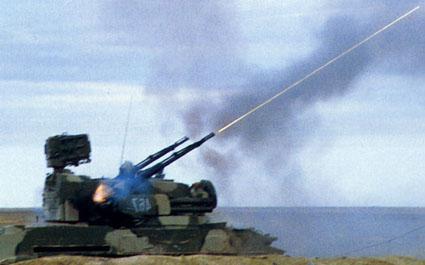
When firing rockets were used for target tracking angular coordinates with an optical sight. After launching missiles fell into the field of view of the optical direction finder equipment selection coordinate missiles. In light signal from the tracer missiles in equipment elaborated angular coordinates relative to the line of sight SAM goals that came in the computer system. It generates control commands missiles entering the encoder where they are encoded in the pulse sending and tracking station through the transmitter transmitted to the missile. Movement missiles almost the entire trajectory happened with the deviation from the line of sight to the target 1, 5 g. Y. to reduce the probability of hitting the aim to shoot the optical (thermal) interference traps in the field of view of the direction finder. Putting missiles at the target line of sight began to 2-3 before meeting with a view and ended near her. When approaching missiles to the target at a distance of 1000 meters on the rocket transmitted radio commands to arming non-contact sensor. When the time corresponding to the flight of a rocket 1000 m from the target, a fighting machine automatically translated in readiness for the next launch missiles at the target.
In the absence of a computer system information about the distance to the target from the tracking station or detection used an additional mode of missile guidance, in which rocket directly output to the line of sight of the target, proximity sensor cocked 3, 2 seconds after launch missiles and bring war machine in readiness for next rocket launch was carried out after the time a missile at maximum range.
Organizational 4 combat vehicles of the complex "Tunguska" anti-aircraft missiles were limited to artillery platoon anti-aircraft missile and artillery battery consisting of a platoon SAM "Strela-10SV" and platoon complexes "Tunguska". Battery included in the anti-aircraft battalion of motorized infantry (tank) regiment. As the battery commander's point control unit used PU-12M, which was connected to the command post of the commander of the anti-aircraft division - Head of Air Defence Regiment. As the last used control point air defenses Regiment "Gadfly-M-SV" (mobile point of exploration and management PPRU-1) or its modernized version - "Build" (PPRU-1M). Later armored complex "Tunguska" were to mate with a standardized battery commanding point 9S737 "Rankings".
Source:
Designed to protect the tank and motorized rifle objectives of low-flying aircraft and helicopters, some types of cruise missiles and to destroy ground lightly armored targets and manpower.

Features of the complex: - combined missile-gun armament; - Combined radar and optical control system of missile and gun armament undertaking vzaimokoordinirovannoe target tracking missiles, and night and day under the conditions of optical visibility. The system provides: - high accuracy of aerial target, regardless of the height of its flight, shelling land targets; - Passive mode of air targets and high noise immunity; - High reliability and stability of the complex when using the optical channel with a radar channel vzaimokoordi- nated by their operation, that is, the possibility of transition to the process of shooting from one channel to another or joint use; - Universality of combat use, ie effective engagement of air targets, not only as a key, but the ground lightly armored vehicles and enemy; - Effective engagement of targets cannon armament in motion, with short stops; - Automatic guided missiles (with correction of small deviations operator guidance); - Short reaction time (6 - 10); - Off-line combat operation; - Automatic exchange of information with the battery command post (improving the efficiency of combat battery); Complex (battery) "Tunguska-M1» includes: anti-aircraft guns 2S6M1 (6 tanks in the battery), surface-to-air missile 9M311-1M (8 missiles on launchers), 30-mm rounds, transportation and loading vehicle 2F77M (up to 3 in the battery ).
The picture dvuzhstvolny anti-aircraft gun.

Missiles complex "Tunguska-M1" - two-stage bikalibernaya surface-to-air missile with a detachable solid booster - 9M311-1M. The missile has a high maneuverability, allowing the striking speed and maneuvering targets. Navede- of missiles at the target - radio. Rocket 9M311-1M delivered to the troops in transport-launch container in the fully equipped condition and requires no maintenance for 10 years.
Gun armament is represented by two double-barreled anti-aircraft guns 2A38M. The high rate of fire (total rate - 5000 rds. / Min.) Can effectively hit the target speed in the zone of fire, even a short time. In combination with high precision targeting by stabilizing the line shots and automatic tracking cannons highly effective in shooting at air targets, including the move. Means of maintenance (MOT) includes: - repair and maintenance of machines 1R10-1M1, 2F55-1M1; - TO 2V110-1 machine; - Workshop MTO SPA; - Automated control and test station 9V921M. They provide: - routine maintenance; - Maintenance and repair during operation and storage. Training facilities and 1RL912 9F810 designed for teaching and training the commander, operator and gunner fighting techniques work in different environments target environment.
Initially the "Tunguska" was seen as a purely gun system, created to replace "Shilka" and differs from it by increasing the caliber automatic antiaircraft guns. The experimental studies have shown that the transition from a shell of caliber 23 mm to 30 mm caliber projectile associated with the two-threefold increase in the mass of the explosive, allows 2-3 times to reduce the number of hits required to destroy aircraft.
In order to expand the zone of fire purposes until the turn of the use of airborne weapons and increase the combat power of the "Tunguska" at the initiative of the PCU MOS and 3 Research Institute of Ministry of Defense it was considered appropriate to put on the ZSU further Missiles with a system of optical sight and radio remote SAM providing engage targets at altitudes of up to 3500 m and at distances up to 8 km. In a duel situation bout combat helicopter with anti-aircraft complex track of time it is not even a second, and their share - it all depends on whose rocket will reach before the enemy, hitting him thwart enemy missile guidance. The smallest missile flight time is provided with rapid acceleration followed by a high-speed flight, but by inertia, speeding, conventional rockets quickly decelerated by air resistance. Tula designers found an original solution. Two-stage rocket made, but the engine was equipped only the first step, made in a rather large caliber - 152 mm. Upon completion of 2, 6 seconds after the start, it was separated without impeding further flight accelerated to velocities of 900 m / s maximum uzhatye twice thinner, good streamlined sustainer stage application of such a scheme allowed halve weight compared with single-stage rocket with the same characteristics, laid in the amount of about 40 kg Most of the cruise stage was elongated rod warhead undermines team from the laser blaster, and a direct hit (the likelihood of which reached about 60%) - contact fuze. The lack of engine sustainer stage preclude smoke boresight target, and on the job site starting rocket engines specially Gone away up practicing "hill." The position determined automatically by a rocket tracer, similar to the way it was done in a semi-automatic anti-tank systems. The use of optical systems to provide an angular pointing accuracy, repeatedly exceeding the performance radar, and the lack of all-weather was not a significant disadvantage, as helicopter gunships in those years, too, could act only in the line of sight of their goals.
Here's how this rocket vygljadet:

Combat gear consists of a rocket warhead, a proximity sensor target and contact fuze. Occupies almost the entire length of the cruise stage warhead weighing 9 kg it is in the form of a large bay with extension rod striking elements, to improve the efficiency surrounded fragmentation jacket. Warhead provide a cutting action on the elements of the airframe goals and incendiary - the elements of its fuel systems in small slips (up to 1, 5 m) also provides a high-explosive action. Undermining the warhead was carried out at a distance of 5 meters from the goal of a non-contact sensor signal, and a direct hit (the likelihood of which reached about 60%) - contact fuze.
The proximity sensor weight 0, 8 kg consisted of four semiconductor lasers forming eight pointed directional pattern perpendicular to the longitudinal axis of the rocket. The reflected laser signal from the target accepted photodetectors. Range confident response was 5 m, a reliable failure - 15 m. The proximity sensor is cocked by radio for 1 km to the meeting with the aim of missiles and missile firing at ground targets from turning off before the start. Restrictions on the height control system of missiles had.
Onboard equipment SAM includes an antenna-waveguide system, electronic control unit, the coordinator gyro unit steering gear, tracer, power supply.
The rocket applied passive damping aerodynamic airframe missiles in flight, which corrects the control loop in the transmission of commands to the computer system of the missile combat vehicle. It is possible to obtain a sufficiently accurate targeting, reduced weight and size of the onboard equipment and missiles in general. The station detection purposes
The station detection purposes combat vehicle complex "Tunguska" is coherently pulsed radar Omnidirection UHF waves. High frequency stability of the transmitter, configured as a master oscillator and amplifier chain, the use of a filter circuit moving target provides a high rejection ratio clutter (30..40 dB) that allows detection of targets against the background of intense reflections from the underlying surface, and clutter. By selecting the carrier frequency and the pulse repetition frequency was achieved unambiguous definition of the range and radial velocity, which allowed to implement target tracking in range and azimuth, automatic target designation station tracking and delivery of the current range in the digital computing system in the formulation opponent intensive interference in the range tracking station . For operation in motion stabilized antenna is an electromechanical method using signals from the sensors and measurement systems kachek creep rate.
When the pulse power 7-10 kW transmitter, receiver sensitivity about 2h10E-14 W, the width of the antenna pattern in azimuth of 5 ° and 15 ° elevation station with probability 0 9 detects fighter flying at altitudes of 25-3500 m, on range 16-19 km. Resolution station was 500 m in range, 5-6 ° in azimuth and 15 ° in elevation. Mean square error in determining the coordinates of the target are within 20 m range, 1 ° in azimuth and 5 ° elevation. Station tracking
Tracking station is a coherent pulse-centimeter-band radar system with dual-channel support on the angular coordinates and the filter circuits moving target channels avtodalnomera corner and automatic tracking. Coefficient of clutter suppression and clutter was 20-25 dB. The station moves to the auto tracking modes targeting the sector and the search target. Sector Search is 120 ° in azimuth and 0-15 ° in elevation.
When the pulse transmitter power of 150 kW, the receiver sensitivity 3h10E-13 W, the width of the antenna pattern 2 degrees. (azimuth and elevation) station with a probability of 0, 9 provide a transition to the auto tracking for the three coordinates of flying at altitudes of 25 - 1000 m the fighter with a range of 10 ... 13 km (with target designation from the station detection purposes), and 7, 5 ... 8 , 00 km (at independent sector search purposes). The resolution of the station was not worse than 75 m in range and 2 degrees. the angular coordinates. Mean square error of target tracking in range is 2 m, and the angular coordinates - 2 PDE
Both stations have successfully detect and track low-flying and hovering helicopters. Detection range of the helicopter, flying at a speed of 50 m / s at a height of 15 m, with a probability of 0, 5 was 16-17 km, the range of the transition to avtosop-rovozhdenie - 11-16 km. Hover the helicopter detected Station detected by the Doppler frequency shift of the rotating screw and took the auto tracking for the three coordinates of the station maintenance purposes.
Stations have circuit protection against jamming and tracking ability in noise due to a combination of use of radar and optical means fighting vehicle. Due to these combinations, separation of operating frequencies of stations, regulated by time or simultaneous work on similar frequencies of several (remote from each other by a distance greater than 200 m) combat vehicles as part of the battery could provide reliable protection against missiles' Shrike 'or' standard workstation »
In the picture: Anti-Aircraft Machine 2A38, anti-aircraft missiles and 9M311 station tracking

Fighting work
The operation was carried out combat vehicle 2S6 largely autonomous, but does not exclude working in the management of air defense SV.
When autonomous operation provides:
* Search purpose (circular - with stations detected, sector - by means of tracking station or telescopic sights);
* Identification of the nationality of the detected aircraft and helicopters using the built interrogator;
* Target tracking by angular coordinates (automatic station tracking with the help of semi-automatic - using the optical sight, inertia - according to the digital computing system);
* Target tracking in range (automatically or manually - using a tracking station, automatic - with the help of the station detection, inertial - using a digital computer system, according to the established rate, which was determined visually by the commander of the selected type to bombard the target).
The combination of different methods of tracking the angular coordinates and range provided by the following mode of operation combat vehicle:
I - for the three target coordinates received from the radar system;
II - for the target range received from the radar system, and its angular coordinates received from the optical sight;
III - inertial target tracking in three dimensions obtained from the computer system;
IV - the angular coordinates received from the optical sight and installed commander of the target speed.
When shooting moving targets on land used semi-automatic mode or manual pointing weapons at the point of pre-emption on the remote grid sight.
Shooting from the anti-aircraft guns
After the search, detection and identification of target tracking station passed at its auto tracking on all coordinates.
When firing anti-aircraft guns digital computer system solves the problem of meeting the projectile with the purpose and determined the affected area according to the data coming from the output shaft antenna tracking station, the block allocation error signals by angular coordinates and range finder, and the system of measuring angles kachek and course of combat cars. In the case of setting an opponent intense noise tracking station on the channel measurement range (avtodalnomera), the transition to manual target tracking in range, and if you can not even hand support - on target tracking in range of the detection station or its inertial accompaniment. Pi staged intense noise tracking station on the angular coordinates target tracking in azimuth and elevation was carried out with an optical sight, and in the absence of visibility - inertia (from digital computing system).

When firing rockets were used for target tracking angular coordinates with an optical sight. After launching missiles fell into the field of view of the optical direction finder equipment selection coordinate missiles. In light signal from the tracer missiles in equipment elaborated angular coordinates relative to the line of sight SAM goals that came in the computer system. It generates control commands missiles entering the encoder where they are encoded in the pulse sending and tracking station through the transmitter transmitted to the missile. Movement missiles almost the entire trajectory happened with the deviation from the line of sight to the target 1, 5 g. Y. to reduce the probability of hitting the aim to shoot the optical (thermal) interference traps in the field of view of the direction finder. Putting missiles at the target line of sight began to 2-3 before meeting with a view and ended near her. When approaching missiles to the target at a distance of 1000 meters on the rocket transmitted radio commands to arming non-contact sensor. When the time corresponding to the flight of a rocket 1000 m from the target, a fighting machine automatically translated in readiness for the next launch missiles at the target.
In the absence of a computer system information about the distance to the target from the tracking station or detection used an additional mode of missile guidance, in which rocket directly output to the line of sight of the target, proximity sensor cocked 3, 2 seconds after launch missiles and bring war machine in readiness for next rocket launch was carried out after the time a missile at maximum range.
Organizational 4 combat vehicles of the complex "Tunguska" anti-aircraft missiles were limited to artillery platoon anti-aircraft missile and artillery battery consisting of a platoon SAM "Strela-10SV" and platoon complexes "Tunguska". Battery included in the anti-aircraft battalion of motorized infantry (tank) regiment. As the battery commander's point control unit used PU-12M, which was connected to the command post of the commander of the anti-aircraft division - Head of Air Defence Regiment. As the last used control point air defenses Regiment "Gadfly-M-SV" (mobile point of exploration and management PPRU-1) or its modernized version - "Build" (PPRU-1M). Later armored complex "Tunguska" were to mate with a standardized battery commanding point 9S737 "Rankings".
Source:

